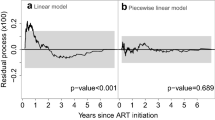Abstract
The Andersen-Gill multiplicative intensity(MI) model is well-suited to the analysis of recurrent failuretime data. The fundamental assumption of the MI model is thatthe process M_i(t) for subjects i=1,⋯,n,defined to be the difference between a subject's counting processand compensator, i.e., N_i(t) ‐ A_i(t); >0,is a martingale with respect to some filtration. We propose omnibusprocedures for testing this assumption. The methods are basedon transformations of the estimated martingale residual process ^M i (t) a function of consistent estimatesof the log-intensity ratios and the baseline cumulative hazard.Under a correctly specified model, the expected value of ^M i (t)is approximately equal to zero with approximately uncorrelatedincrements. These properties are exploited in the proposed testingprocedures. We examine the effects of censoring and covariateeffects on the operating characteristics of the proposed methodsvia simulation. The procedures are most sensitive to the omissionof a time-varying continuous covariate. We illustrate use ofthe methods in an analysis of data from a clinical trial involvingpatients with chronic granulatomous disease.
Similar content being viewed by others
References
P. K. Andersen and R. D. Gill, “Cox's regression model for counting processes: A large sample study,” The Annals of Statistics vol. 10 no. 4 pp. 1100–1120, 1982.
P. K. Andersen, B. Ornulf, R. D. Gill, and N. Kieding. In Statistical Models Based on Counting Processes, 1993.
E. Arjas, “A graphical method for assessing goodness of fit in Cox's proportional hazards model,” Journal of the American Statistical Association vol. 83 pp. 204–212, 1988.
W. E. Barlow and R. L. Prentice, “Residuals for relative risk regression,” Biometrika vol. 75 no. 1 pp. 65–74, 1988.
N. Breslow, “Contribution to the discussion of the paper by D. R. Cox,” Journal of the Royal Statistical Society B vol. 34 pp. 187–220, 1972.
H. Chernoff and E. L. Lehmann, “The use of maximum likelihood estimates in chi-squared tests for goodness of fit,” Annals of Mathematical Statistics vol. 25 pp. 579–586, 1954.
D. R. Cox, “Regression models and liffey tables (with discussion),” Journal of the Royal Statistical Society B vol. 34 pp. 187–220, 1972.
D. R. Cox, “Partial likelihood,” Biometrika vol. 34 pp. 187–220, 1972.
T. R. Fleming and D. P. Harrington, Counting Processes and Survival Analysis, 1991.
R. D. Gill, “Testing goodness of fit of Cox's regression and life model,” Biometrics vol. 38 pp. 67–77, 1982.
R. D. Gill and M. Schumacher, “A simple test of the proportional hazards of assumption,” Biometrika vol. 74 pp. 289–300, 1987.
P. M. Grambsch, T. M. Therneau, and T. R. Fleming, “Diagnostic plots to reveal the functional form for covariates in multiplicative intensity models,” Biometrics vol. 51 pp. 1469–1482, 1995.
S. Kullback, Information Theory and Statistics, 1959.
S. Kullback, “On testing correlation matrices,” Applied Statistics vol. 16 pp. 80–85, 1967.
J. F. Lawless and J. C. Nadeau, “Some simple robust methods for the robust methods for the analysis of current events,” Thechnometrics vol. 37 pp. 158–168, 1995.
D. Y. Lin and L. J. Wei, “Goodness-of-fit tests for the general Cox regression model,” Statistics Sinica vol. 1 pp. 1–17, 1991.
D. Y. Lin, L. J.Wei, and Z. Ying, “Checking the Cox model with cumulative sums of martingale-based residuals,” Biometrika vol. 38 pp. 557-572, 1993.
J. K. Lindsey, “Fitting parametric counting processes by using log linear models,” Applied Statistics vol. 44 pp. 201–212, 1995.
E. Peña, “Smooth goodness-of-fit tests for composite hypothesis in hazard based models,” The Annals of Statistics vol. 26 pp. 1935–1971, 1998.
D. A. Pierce, “The asymptotic effect of substituting estimators for parameters in certain types of statistics,” The Annals of Statistics vol. 10 pp. 475–478, 1982.
D. Schoenfeld, “Partial residuals for the proportional hazards regression,” Biometrika vol. 69 no. 1 pp. 239–241, 1982.
C. F. Spiekerman and D. Y. Lin, “Checking the marginal Cox model for correlated failure time data,” Biometrika vol. 83 pp. 143–156, 1996.
G. P. H. Styan, “Notes on the distribution of quadratic forms in singular normal variables,” Biometrika vol. 57 pp. 567–572, 1970.
The International Chronic Granulatomous Disease Study Group, ”A controlled trial of interferon gamma to prevent infection in chronic granulatomous disease,” The New England Journal of Medicine vol. 324 pp. 509–516, 1991.
T. M. Therneau, P. M. Grambsch, and T. R. Fleming, “Martingale-based residuals for survival models,” Biometrika vol. 77 pp. 147–160, 1990.
T. M. Therneau and S. A. Hamilton, “rhdnase as an example of recurrent event analysis,” Statistics in Medicine vol. 16 pp. 2029–2047, 1997.
L. J. Wei, D. Y. Lin, and L. Weissfeld, “Regression analysis of multivariate failure time data by modeling marginal distributions,” Journal of the American Statistical Association vol. 84 no. 408 pp. 1065–1073, 1989.
I. Yang, D. Y. Lin, Z. Ying, and L. J. Wei, “Robust inferences for the Andersen-Gill counting process model,” Unpublished Manuscript, Harvard School of Public Health, 1999.
Author information
Authors and Affiliations
Rights and permissions
About this article
Cite this article
Jones, C.L., Harrington, D.P. Omnibus Tests of The Martingale Assumption in The Analysisof Recurrent Failure Time Data. Lifetime Data Anal 7, 157–171 (2001). https://doi.org/10.1023/A:1011396706243
Issue Date:
DOI: https://doi.org/10.1023/A:1011396706243



